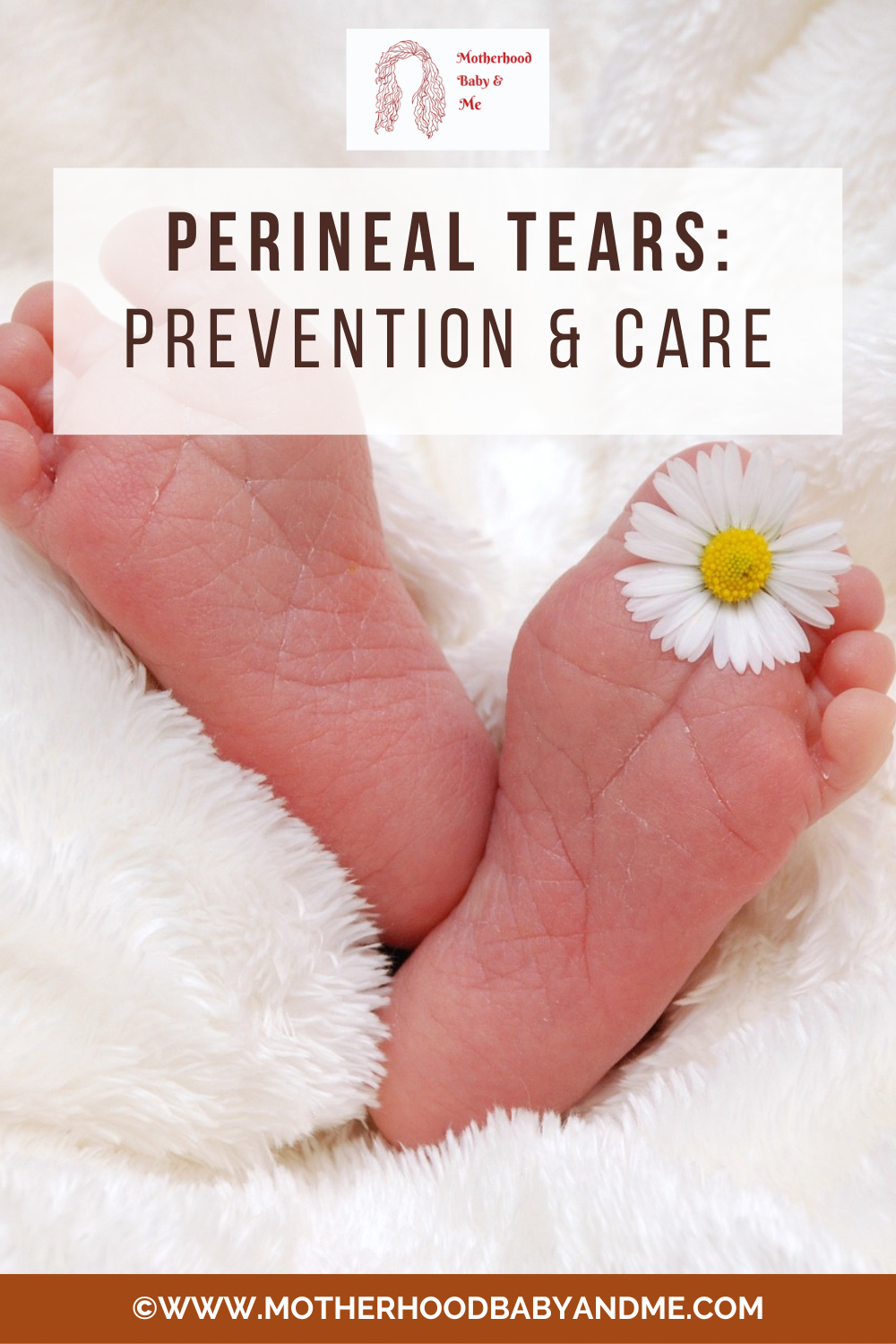Perineal tears: prevention and care. This is probably not a topic you have heard discussed a whole lot. Perineal tearing is painful, scary, and life changing. How bad you tear is dependent upon several factors. What can you do to prevent tearing? How do you care for your tear and stitches during the healing period? We will discuss all of these things in this article! If you are a first-time-mom expecting your baby, it is crucial you educate yourself on this topic before giving birth. You want to be as prepared and knowledgable as possible on this subject! If you are a seasoned mom, the information in this article can still help you gain understanding on how you can best care for your perineum if you tear.
Where Is The Perineum?

Where is the perineum? Many women don’t know where their perineum is, or even what it is! I had no idea what my perineum was until well after I had healed from my awful tear during child birth. If you look at the picture above, you will see a gray image of a woman’s pelvic floor area. This is the area you sit on. You can see the vagina, anal canal and some muscles pointed out.
The perineum is the skin that is directly between the vagina and anal canal. What is it’s job? It protects the pelvic floor muscles. To learn more about what the pelvic floor is and it’s role in the body, read my article What Is The Pelvic Floor?.
Additionally, the perineal is responsible for protecting the blood vessels to the vagina and bladder. During sex, blood rushes to the vagina to aid in arousal and stimulation. Low blood supply to the vagina can have negative affects on sex. This makes the perineum super important. We need to do what we can to protect it and care for it during and after pregnancy.
Perineum Tearing
There are different “degrees” or “severities” of perineal tearing. It is important to understand these so you can be knowledgable about what goes on with your body after delivery! The last thing you want is to be holding your baby with the doctor stitching you up for several minutes, and you don’t know what he is stitching exactly (I speak from personal experience!).
1st Degree Tear
This is the least severe type of perineal tearing. It is the kind of tear all women aim for if they say they prefer to tear and refuse an episiotomy. With a 1st degree tear, only the skin is torn. In this case, the body may heal on its own and no stitches will be necessary. Yay!
2nd Degree Tear
This tear occurs in the skin and muscle of the perineum. Usually, stitches are needed to treat this kind of tear. Although this would be uncomfortable for the mom, it is not as uncomfortable as a 3rd degree tear!
3rd Degree Tear
This type of tearing is rare (about 1-3.5 in 100 women have 3-4 degree tears during labor). With a 3rd degree tear, the tear affects the muscle controlling the annas. Mothers with this tear may experience difficulty holding their poo in while healing. This is normal, but embarrassing! Stitches are needed to mend this tear.
There are some factors that increase your risk for a 3rd degree perineal tear. Let’s look at these. (The following are according to an article from the National Library of Medicine, 2021. PMCID: PMC8398826)
- Giving birth for your first time
- Induced labor
- Receiving an episiotomy
- Forceps or spatula used during labor
- Baby weighs 6.61 lbs. or more
Mothers experiencing a 3rd degree tear should seek pelvic floor therapy. This is to bring strength and normal function back to the muscles that were torn and mended.
4th Degree Tear
This is the worst kind of perineal tearing! When this tear occurs, there is a complete rip from the vagina to the anal canal. Stitches are required to mend this tear. The healing process is very painful, difficult to live with, and inconveniencing. Mothers who experience this type of tear absolutely need to seek pelvic floor therapy and have lots of patience with themselves as they heal.
Like What You’ve Found? PinIt!

Caring For Your Perineal Tear
This article is titled “Perineal Tears: Prevention and Care”. What are you to do if you tear during labor? If you do tear during labor, how should you care for it? Some mothers may be at a loss here. Perhaps they weren’t expecting to tear, like me. However, it happened. Let’s discuss how to best care for our tears now.
Needed Supplies
There are some essential supplies you will need to help bring healing and comfort to your perineum and stitches while you heal.
Sitz Bath
A sitz bath is a bowl you place on the toilet. Fill it with warm water and then sit down. The warm water bring comfort to the stitches, keeps them smooth, and helps you feel better too.
It comes with a plastic tube that allows you to fill the bowl with more warm water as you sit. There are holes in the back of the bowl that allow overflow to fall into the toilet. No mess on the floor!
A sitz bath is a necessity for mothers healing from perineal tears! Also, they offer great comfort for hemorrhoids as well – another health risk after giving birth. There are different kinds of sitz baths, as I will show you below.
Always be sure to wash your product before its first use!

This electric sitz bath will be more comfortable for mothers who experienced a 3-4th degree perineal tear. Since it is electric, it does not have the cord in the back.
I suffered from a 3-4th degree tear and did not have an electric sitz bath. The tub that supplied water to the bath would surprisingly poke me in my pelvic floor area – right where I was trying to heal! Also, I didn’t like having the tube by my butt since I was also healing back there! Wish I had this electric sitz bath for myself. It would have been so much nicer and convenient!
What We Like About It
- Harsh chemical free
- No tube in the back to refill basin
- Place to put herbs to aid in healing
- Foldable
What We Don’t Like About It
Without the tube to refill the sitz bath with warm water, you can’t replenish the bath.

What We Like About It
- Brings relief to perineal tearing
- Helps heal hemorrhoids
- Fits various shapes of toilets
- Collapsable
- Comes with a hook to hang the warm bag of water on
- Personal towel comes with it
- BPA free
What We Don’t Like About It
Some think it holds too little water. However, most love this sitz bath!
Witch Hazel Pads

Witch hazel is a plant. Different parts of the plant are used to make medicine. It can be applied to the skin for many different ailments including swelling, minor bleeding, irritation, and fighting bacteria. Witch hazel pads are a necessity while healing from a perineal tear! Simply apply as many as you like directly to your maxi pad. You can switch them out as often as you feel is necessary.
If you don’t enjoy lining your maxi pad with witch hazel pads, I would recommend buying a bottle of witch hazel. Then you can squirt the witch hazel onto your pad. That may be more comfortable for some.
What We Like About Them
- Witch hazel is a plant
- The medicine is natural
- Disposable pads
- Brings healing
- Reduces swelling
- Aids in comfort
- Helps heal the skin
- Reduces bleeding
What We Don’t Like About Them
Some may not like sitting on loose pads. In that case, the bottle of witch hazel may be preferred.
Bottle of Witch Hazel

The bottle of witch hazel may be preferred to some over the pads. It is the same great witch hazel, only in a bottle! You can even mix some witch hazel in with the water in you peri bottle for additional healing aid.
What We Like About It
- All great affects of witch hazel only in a bottle!
- Convenient
- Portable
What We Don’t Like About It
Some may be confused as to how much witch hazel to apply to a pad. However, you can’t use too much!
Peri Bottle

Preventing Perineal Tearing
Some may tell you that you can’t prevent perineal tearing. Whatever may happen will happen. If you’re gonna tear, you’re gonna tear. However, that is pretty old advice. Plus, logically it doesn’t make sense. The perineum is skin and muscle. What do we do prior to a workout? We stretch and warm up, right? Why do we do that? To prevent injury!
The same is true for the perineum. So how can we prevent perineal tearing during delivery? Here are two tips I have for you! Ready?
Tip 1: Stretch Your Perineum
Stretch your perineum. How do you do that, you might be wondering? It is simple. Follow these steps below.
- Wash your hands and make sure your nails are short
- Get a good lube or coconut oil on your fingers
- Rub your fingers back and forth on your perineum in a sweeping motion. Don’t try to be rushed here. Be gentle and slow with yourself. No need to cause anxiety here!
- After sweeping your perineum to “warm it up”, apply pressure to the perineum. Start on one side and work your way down to the other side. You want enough pressure to feel like you’re stretching the muscle, but it should not be painful.
- Wash your hands when done
Tip 2: Ask To Be Lubed Really Well Before Baby Crowns!
This was something my midwife did for me before my baby was born and I hardly tore! If the baby can slip out easier, it will put less friction on your perineum. If you want, mark this step down in your Birth Plan paper that you hand to the medical staff.
I would highly recommend this tip to preventing perineal tearing!
Summary
After reading this article, Perineal Tears: Prevention and Care”, you are well educated on perineal tearing, prevention and care! You understand the role of the perineum, the importance it has in the body, and how to best care for it. Additionally, you know the risk factors the put you at a greater risk for tearing. However, you also know how to reduce those risks by taking the steps to “warm up” your perineum before delivery!
I am proud of you, Mama, for reading this article “Perineal Tears: Prevention and Care”, and taking the health of your perineum seriously! If you enjoyed this article, share it so other mothers can be educated as well!
Leave A Comment Below!

What encouraged you from this article? Share your thoughts with us in the comments below!
Want To Know More?
Did you enjoy this article “Perineal Tears: Prevention and Care”? If so, check out these other articles to learn more about perineal care and vaginal health!
Additionally, if you are a mother who is healing from a C-section and looking for natural remedies for healing from that. Be sure to check out my friend Tin’s article Natural Remedies For Postpartum Healing.
Best Kegal Balls For Strengthening The Vagina
How A Strong Vagina Impacts Women’s Health
The Pelvic Floor Wand – How To Relax And Massage The Pelvic Floor Muscles
Best Vaginal Moisturizers And Lubricants
